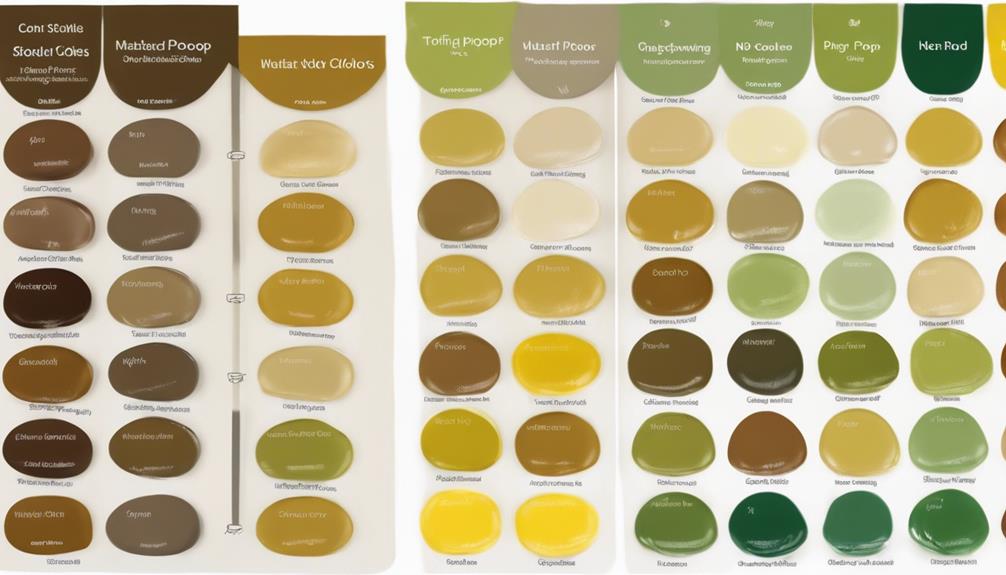Imagine this: you're changing your baby's diaper, and suddenly you notice something different about their poop. It's frothy. But what does this mean?
Understanding the characteristics of frothy poop in your newborn can provide valuable insight into their health. Let's unravel the mystery together and shed light on this topic that might just ease your mind.
Key Takeaways
- Frothy poop in newborns can indicate digestive issues.
- Consult a lactation consultant for guidance on frothy stool.
- Monitor color variations for clues on digestive health.
- Seek healthcare provider advice for concerns about frequency and consistency.
Characteristics of Frothy Poop
When observing frothy poop in newborns, it's essential to note its bubbly or airy texture, which distinguishes it from typical baby stool. This unique consistency can be concerning for parents, especially those with breastfed babies.
The digestive tract of a breastfed baby is delicate and can be impacted by various factors, such as the mother's diet or feeding techniques. Consulting a lactation consultant may provide valuable insights into potential dietary adjustments that could help alleviate frothy poop issues.
Understanding the intricacies of the digestive system in newborns is vital in identifying and addressing abnormal stool textures. A lactation consultant can offer guidance on proper breastfeeding techniques to minimize air intake during feeds, which may reduce the likelihood of frothy poop.
Normal Vs. Abnormal Texture

In newborns, distinguishing between normal and abnormal stool textures involves closely examining the presence of frothiness or foaminess in the baby's poop. When it comes for breastfed infants, the texture of their poop can vary, but understanding what to look for can help differentiate between what's typical and what may require attention.
- Normal Breastfed Baby Poop: It may exhibit a slightly frothy consistency, attributed for air incorporation during feeding sessions.
- Abnormal Frothy Poop: Excessive frothiness could signal issues like increased gas levels or difficulties digesting lactose.
- Associated Symptoms: If frothy poop is coupled with symptoms such as fussiness or unexplained weight loss, seeking advice from a pediatrician is advisable.
- Management Strategies: Keeping a close eye on feeding routines and making necessary dietary adjustments can often help alleviate frothy poop concerns in breastfed newborns.
Understanding the nuances of breast milk digestion can aid in recognizing when frothy poop deviates from the norm.
Color Variations to Watch For
Color variations in a newborn's poop can provide valuable insights into their digestive health and overall well-being. When it comes to breastfed babies, different colors can indicate various factors such as the presence of gas or potential digestive issues. Below is a table detailing color variations to watch for in your newborn's poop:
| Color | Indication |
|---|---|
| Yellow | Normal in breastfed babies, can be a sign of healthy digestion. |
| Green | Could suggest an imbalance in gut flora or too much foremilk. |
| Brown | Generally a healthy color, indicating good digestion. |
| Red | Seek medical advice immediately as it may signal blood in the stool. |
Monitoring these color variations, especially in breastfed babies, can help detect early signs of digestive issues like gas or imbalances in gut flora. If you notice persistent abnormal colors or have concerns about your baby's poop, consulting a healthcare provider is essential for proper evaluation and guidance.
Frequency and Consistency
Monitoring the frequency and consistency of your newborn's stool is essential in evaluating their digestive health and overall well-being. Here are some key points to contemplate when observing your baby's poop:
- Frequency: Newborns typically pass stool multiple times a day, especially after feeding. Changes in the frequency of bowel movements might indicate an issue with digestion or feeding.
- Consistency: Normal newborn poop is soft and may resemble mustard, with a seedy texture. If the poop is consistently frothy or watery, it might be a cause for concern.
- Health Care Provider: If you notice persistent frothy poop or any other unusual changes in your baby's stool, it's advisable to seek guidance from a healthcare provider.
- Feeding Times: Keeping a record of your baby's feeding times and stool consistency can help identify any potential correlations between feeding patterns and frothy poop.
Potential Health Implications
Observing frothy poop in a newborn can signal potential health implications related to malabsorption, lactose intolerance, gut bacteria imbalance, or infections. When it comes to your baby's poop, changes in consistency and texture can provide valuable insights into their digestive health. Here's a breakdown of the potential health implications associated with frothy poop:
| Health Implication | Description |
|---|---|
| Malabsorption | Frothy poop may indicate the inadequate absorption of nutrients in the digestive system. |
| Lactose Intolerance | It could be a sign of lactose intolerance or a reaction to certain foods in the mother's diet. |
| Gut Bacteria Imbalance | Excessive frothiness might be linked to an imbalance in gut bacteria, affecting digestion. |
| Infections | In some cases, frothy poop can be a result of infections that need prompt medical attention. |
| Discomfort for the Baby | Frothy poop can lead to discomfort for the baby, including gas, bloating, and potential irritability. |
Understanding these potential health implications can help you address any underlying issues promptly and ensure your baby's well-being. If you notice persistent frothy poop or accompanying symptoms like weight loss or dehydration, consulting a healthcare provider is important for proper evaluation and management.
Frequently Asked Questions
What Does Frothy Baby Poop Look Like?
Frothy baby poop appears bubbly and airy, with a foamy consistency. It may have various colors, but the texture distinguishes it. This type of poop can signal excess gas or fast digestion. Persistent frothy poop warrants a healthcare provider's evaluation.
What Does Foamy Poop Look Like?
Foamy poop in newborns presents as airy, resembling bubbly foam. It can indicate digestive issues. Seek a pediatrician's guidance if it persists. Excessive air in the gut may contribute to this appearance, warranting medical attention for proper evaluation.
Green Frothy Poop in a Breastfed Baby Is Most Likely an Indicator of a Foremilk/Hindmilk Imbalance
We agree that green frothy poop in a breastfed baby often signals a foremilk/hindmilk imbalance. This imbalance can result from insufficient time on one breast. Consulting a professional can help resolve this issue effectively.
What Does Milk Allergy Poop Look Like?
We recognize milk allergy poop as green, watery, and mucus-filled. Symptoms extend to skin rashes, colic, and vomiting. Blood in the stool hints at severe allergy. Seek medical advice for confirmation and guidance.
Conclusion
Just as a stormy sea may churn and froth, so too can your newborn's poop appear frothy at times. Remember, like a skilled sailor steering through rough waters, you can steer the world of newborn poop with knowledge and guidance.
Keep an eye on the characteristics, colors, and frequency of your baby's poop, and seek help if needed to guarantee smooth sailing on your parenting journey.










